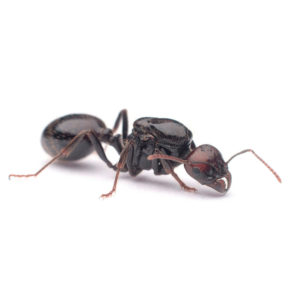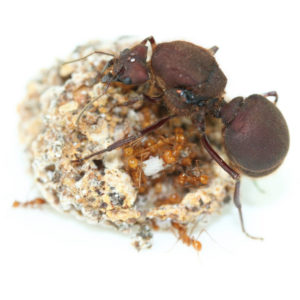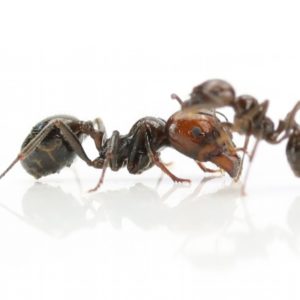Myrmica rubra – Colony with Queen and Workers
Good hunters, capable of stinging their prey, attractive brown-red color. Excellent aphid breeders.
Description
The Ant Farming Charter on our Myrmica rubra ants:
1. Breeding approved by the Veterinary Services, led by a specialist with a certificate of competence,
2. Guide to the Perfect Ant Farmer offered and health sheet provided,
3. Ants guaranteed free of parasites,
4. Health demonstrated by the laying of the queen and the presence of brood on dispatch,
5. No “boost” (addition of brood or external workers to sell the colonies faster),
6. Delivery guaranteed in good health: partial refund in the event of loss of workers, total in case of loss of the queen (if delivered within 48 hours),
7. Shipping possible from -12°C to +40°C thanks to our optional insulated packaging,
8. Species present in France, non-invasive and not threatened,
9. Colony taken back and costs covered if you wish to part with it (see conditions)
______________________________________________________________________________________________
Myrmica rubra is often called the Red Ant and is appreciated in captivity because it thrives in moderate temperatures while being aggressive, which makes it possible to observe its hunting behavior with small prey.
Perfectly capable of overcoming fruit flies and micro-crickets, it is advisable to remain reasonable on the size of the prey. It is possible to feed Myrmica rubra thawed insects for convenience. The sting is rather painful at the time but fades quickly and is not dangerous for humans.
Myrmica rubra is easy to feed because it likes sweet foods very much also because of its habit of consuming aphid honeydew. However, it stores little food and must be fed as often as possible (minimum 3x per week for good results).
The evolution of Myrmica rubra is quite slow at first but accelerates with the number of queens because this species can have several per colony. Rubra is one of the largest Myrmica, it is active and aggressive, which makes it very interesting to observe and among our top recommendations.
Myrmica rubra swarms in July and August and it is common to find a large number of princesses and winged males in the wild or in parking lots. We recall, however, that only wingless individuals are likely to lay eggs for sure. We offer colonies from fertilized queens, either with foundation from the queen alone after swarming, or from giant colonies from our breeding. We benefit from well-controlled swarming in captivity and can thus found healthy colonies quickly.
The humidity requirement of Myrmica rubra is high and it is found in cool areas along roadsides, at the edge of forests. In breeding, do not hesitate to offer a heated area of the anthill for the brood, while leaving most of the nest at a moderate temperature. Most of the nest should be very moist. Please push the humidity of your anthill to the maximum.
Myrmica rubra breeding sheet:
Size of queens: about 7mm
Size of workers: about 5mm
Food: sweet liquids, jellies, insects.
Humidity: Very high, moisten the anthill well over a large area.
Contact us if necessary for a suitable anthill. Temperature: around 24°C, possibly 27°C on a small part of the nest.
Fear high temperatures. Wintering: 3 months at 8 to 17°C, possibly shorter. Keep an eye on the humidity and continue to feed the ants during this period.
Incompatible with gel anthills, like all queen colonies!
Photo of Myrmica rubra N°3 by Nikola Rahmé. Gallery here. Photo N°1, 2 & 4 by Steb1. Gallery here.
Further information
| Weight | 0.2kg |
|---|---|
| Success insurance 3 months | |
| Number of queens | |
| Number of workers |







